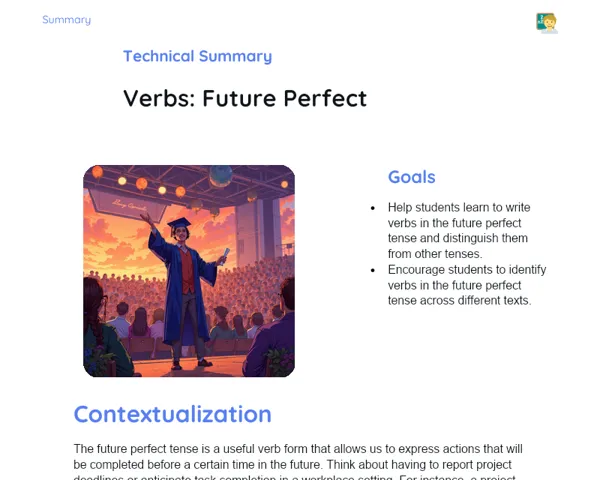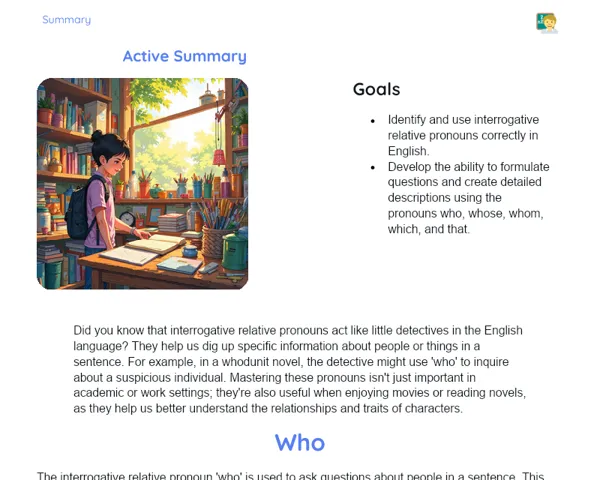Objectives
1. Identify and correctly use the relative pronouns 'who', 'which', 'that', and 'whose', recognising their functions in various contexts.
2. Enhance your written and spoken communication skills by using relative pronouns to connect ideas and information smoothly.
3. Appreciate the role of relative pronouns in academic and professional settings, applying them in texts and conversations to foster clarity and coherence.
Contextualization
Did you know that relative pronouns are like little detectives in English? They link information and clarify what’s being said, making communication more precise and fluent. Picture reading a book without these 'detectives'... it would be confusing and less engaging. Similarly, using relative pronouns correctly when writing or speaking is vital to avoid misunderstandings and ensure your ideas shine through clearly. Mastering these pronouns not only boosts your grammar but also makes you a more effective and persuasive communicator!
Important Topics
WHO
The relative pronoun 'who' is used for referring to people and can act as a subject or object in a sentence. It connects information about a person, making communication clearer and smoother. For instance, in 'The woman who won the marathon is my neighbour', 'who' refers to 'the woman' and serves as the subject of the relative clause.
-
Used for people (as subject or object).
-
Links information about the same person in a sentence.
-
Crucial for forming complex and detailed sentences.
WHICH
'Which' refers to things, animals, or concepts and is used to add extra information about something mentioned earlier. It usually appears in non-restrictive relative clauses, which aren’t crucial to the main meaning of the sentence. For example, in 'I bought a new car, which is very fast', 'which' adds additional information about the car.
-
Used for things, animals, or concepts.
-
Introduces non-essential extra information.
-
Helps maintain fluency in both writing and speech by providing details.
THAT
'That' can refer to people, things, animals, or ideas and is used in both restrictive and non-restrictive clauses. It’s commonly used in informal contexts and is versatile enough for any type of antecedent. For example, in 'The book that I bought is on the table', 'that' refers to the book and is necessary for the sentence.
-
Universal reference (can refer to people, things, etc.).
-
Used in both restrictive and non-restrictive clauses.
-
Frequently seen in informal and conversational contexts.
Key Terms
-
Relative pronoun: A word that connects a relative clause to the main sentence, referring to an element mentioned earlier and helping to combine information more effectively.
-
Subject: The part of a clause or sentence about which something is stated. The relative pronoun 'who' can function as the subject in a relative clause.
-
Object: The part of a clause or sentence that the verb affects. The relative pronouns 'who' and 'which' can function as objects, depending on the context.
For Reflection
-
How might incorrect use of relative pronouns affect clarity and understanding in a text or conversation?
-
Why is it important to grasp the difference between restrictive and non-restrictive clauses when using relative pronouns?
-
In what ways can mastering relative pronouns enhance your communication and expression skills in English?
Important Conclusions
-
In this lesson, we delved into the relative pronouns 'who', 'which', 'that', and 'whose', and their importance for connecting information to make our English communication clear and precise.
-
We reviewed practical examples and discussed how each relative pronoun is applied in different contexts, aiding in the construction of more complex and detailed sentences.
-
Understanding and correctly applying relative pronouns not only enhances our grammar but also significantly improves our ability to express ideas effectively and coherently.
To Exercise Knowledge
- Relative Pronoun Usage Diary: For one week, maintain a diary noting the situations where you used relative pronouns in English. Aim to use each relative pronoun multiple times, and reflect at the week's end to check for correct usage. 2. Rewrite and Correct: Find a newspaper article or a short story and rewrite some sentences by swapping the relative pronouns used with others. Then, amend your new sentences and discuss the shifts in meaning. 3. Family Discussion: Pick a topic to discuss as a family and strive to use relative pronouns in your speech. Encourage other family members to spot and correct your pronoun usage.
Challenge
🚀 Linguistic Detective Challenge: Create a small mystery or riddle for your family or friends. Write clues using relative pronouns to lead them to the solution. For instance, 'The person who has the red hat is the key to the puzzle.' See who can solve the mystery using the relative pronoun clues!
Study Tips
-
Use flashcards to get the hang of relative pronoun usage. On one side, jot down a sentence with a blank for the relative pronoun, and on the other side, write the pronoun that should fit. This aids in memorisation and practical usage.
-
Watch English movies or series and try to identify relative pronouns in action. This can be particularly helpful in grasping the context in which different relative pronouns are commonly used.
-
Practice writing small paragraphs or dialogues employing relative pronouns. Ask a colleague or fellow teacher for feedback on your pronoun usage and placement.


